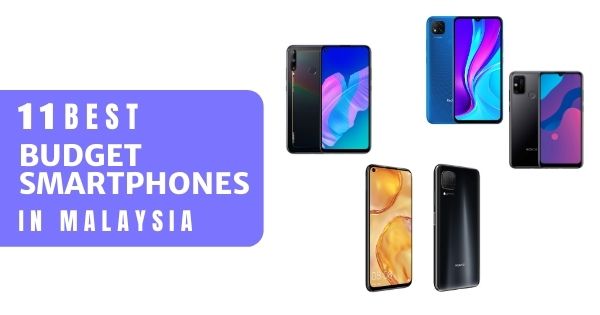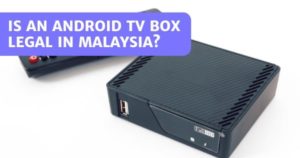Not everybody needs a high-end Smartphone. The best budget Smartphones in Malaysia may be just what you’re looking for!
So we have listed the cheapest Smartphones under RM1,000 that serve functionality and style!
However, if you can afford to save up for one, go for these best Smartphones below RM2,000 instead. For higher performance and reliability!
11 Best Budget Smartphone In Malaysia 2023
- POCO X5 Pro – Best Overall Budget Smartphone
- Redmi Note 12 – Most Affordable AMOLED Display Smartphone
- OnePlus Nord CE 3 Lite – Best All-Round Budget Smartphone
- Realme 10 – Best Compact Budget Smartphone
- Vivo IQOO Z7 – Best Performing Smartphone Under RM1500
- realme narzo 50 – Best For Gaming
- Samsung A13 – Best Samsung Budget Phone
1. POCO X5 Pro – Best Overall Budget Smartphone
The latest POCO X5 Pro is a stellar device that does a little bit of everything. The first thing you’ll notice is the display, a large and vibrant 6.67-inch AMOLED panel with a 120Hz refresh rate.
And it’s fairly sharp too thanks to the 2400 x 1080 resolution. In terms of display, it’s among the best with a good size, sharpness, and a vibrant AMOLED panel.
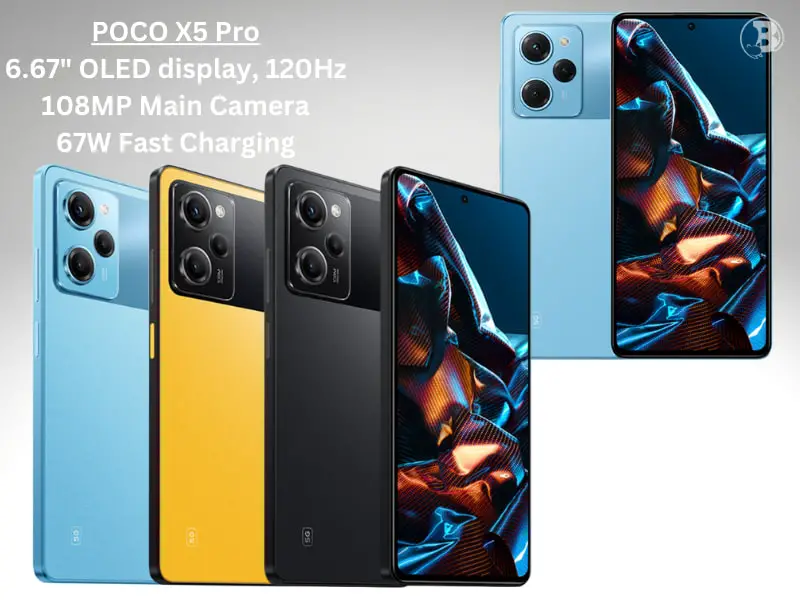
The X5 Pro is also a great performer thanks to the Qualcomm Snapdragon 778G processor. It isn’t the best performer on the list, but it’s a close second place. This is paired with either 6GB / 8GB RAM and up to 256GB storage.
The storage is slightly limited and it doesn’t have an external SD card slot. So, you’re stuck with only up to 256GB of storage. Not ideal, but it’s good enough if you use cloud services for most of your photos, files, etc.
The cameras on the X5 Pro are formidable shooters with a 108MP main camera, an 8MP ultrawide, and a 2MP macro. The selfie camera is a 16MP sensor which is decent enough for selfies and portrait shots.
Though night mode performance isn’t the X5 Pro’s strong suit. Photos in dim lighting conditions tend to be grainy, and not as detailed. This is common for budget smartphones but it’s great in well-lit settings.
Compared to last year’s POCO X4 Pro the X5 Pro mainly upgrades the performance with the Snapdragon 778G chip. It’s a big leap in performance but if you already have last year’s model, it’s best to skip the X5 Pro because they’re almost identical.
Overall, the POCO X5 Pro is a great budget smartphone that covers every area.
You get a big, sharp AMOLED display, a long-lasting 5000mAh battery, and a 108MP camera. It is slightly pricier than other options starting at RM1399, but for the price, it’s an impressive package.
Pros:
- Large & Vibrant 6.67-inch AMOLED Panel
- Snapdragon 778G Processor
- 67W Turbo Charging & 5000mAh Battery
- 108MP Main Camera
- X-Axis Haptic Feedback (Crisper vibrations & haptics)
Cons:
- Plastic Build
- Slightly Expensive for a Budget Smartphone
- Limited Storage Options
2. Redmi Note 12 – Most Affordable AMOLED Display Smartphone
The Redmi Note 12 is one of the best options available if you wanted a smartphone with an AMOLED display and don’t want to spend much. It starts at RM699 so it’s a really affordable smartphone for what it offers.
The most impressive spec is the display; a 6.67” AMOLED display with a 2400 x 1080 resolution and 120Hz refresh rate.
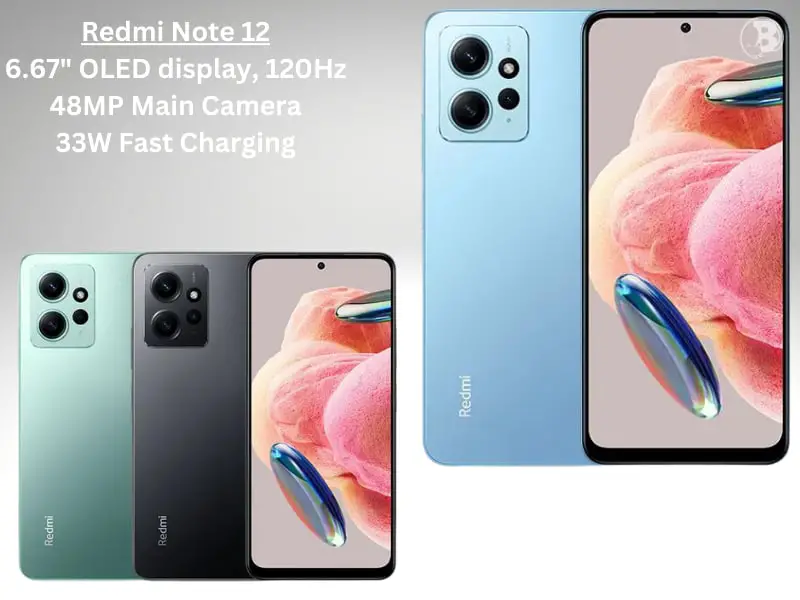
Considering that AMOLED panels and a high refresh rate used to be reserved only for flagship phones, it’s impressive you can get it on a phone that’s under RM1000.
Powering the Note 12 is the Qualcomm Snapdragon 685 chip. It’s a decent performer but don’t expect ultra-settings in games, or lag-free usage with heavy multi-tasking. You can pair it with either 4GB/6GB/8GB RAM and up to 128GB storage space.
As a smartphone, the Redmi Note 12 isn’t the most powerful. It’s fairly limited in its ability to handle high-graphic games or intensive apps.
But at least the Redmi Note 12 has a competent camera setup with a 50MP main camera, 8MP ultrawide, and 2MP macro camera. The selfie camera is a simple 13MP sensor but it supports HDR for colourful, vibrant selfies.
It also has a 5000mAh battery and supports 33W fast charging. The phone charges back relatively quickly with the 33W fast charge, but it isn’t as impressive as other phones that support faster charge speeds.
Compared to last year’s Redmi Note 11, the Redmi Note 12 has a faster 120Hz refresh rate, an upgraded processor, and a larger & brighter display. It’s a pretty big jump from last year’s model so you can consider upgrading.
As a whole, the Redmi Note 12 packs in a lot of great features.
The display is solid considering the RM700 price tag and it’s a decent performer too. The caveat is it probably won’t be as reliable for power users, so keep that in mind before deciding on the Redmi Note 12.
Pros:
- AMOLED Display for Under RM1000
- 50MP Main Camera
- Value-for-Money Snapdragon 685 Processor
- All Day Battery Life
- Simple & Attractive Design
Cons:
- Charging Could Be Faster
- No 5G Support
- Can’t Keep Up in High Graphic Games/Heavy Multitasking
3. OnePlus Nord CE 3 Lite – Best All-Round Budget Smartphone
If you were in the market for an all-round budget smartphone, the OnePlus Nord CE 3 Lite is your best bet. It’s a jack of all trades and doesn’t do just one thing exceptionally well. It focuses on giving you the best of the basics.
The OnePlus Nord CE 3 Lite features a 6.7-inch LCD display with a 2400 x 1080 resolution and supports a 120Hz refresh rate.

Here’s the first compromise we noticed to keep costs down, as the Nord CE 3 Lite doesn’t feature an AMOLED like the POCO X5 Pro or the Redmi Note 12. This means the display isn’t as vibrant or punchy.
But it’s still sharp, smooth, and bright enough.
It also sports a decent processor, the Qualcomm Snapdragon 695 which is a step ahead of the Redmi Note 12. It isn’t a big leap in performance but it is noticeably faster in day-to-day performance.
You can pair it with a generous 8GB RAM and up to 256GB storage space. You can expand the storage with a microSD card if you need to.
It’s also a great battery performer with a 5000mAh battery and a speedy 67W SUPERVOOC fast charging support.
Not to mention it features a headphone jack and has the latest Android 13 pre-installed. Budget models tend to have older Android versions, so the Nord CE 3 Lite will last longer with more OS and security updates.
Compared to the previous model, the OnePlus Nord CE 2 Lite, the CE 3 Lite features a larger, brighter screen, improved 108MP main camera, stereo speakers, and faster 67W charging.
The only real downside of the OnePlus Nord CE 3 Lite is the missing AMOLED panel. Including an AMOLED display would’ve made this one of the best phones in the category. But if you can look past that, the Nord CE 3 Lite has a lot to offer.
It isn’t the best in one category, but it covers each spec to a ‘good-enough’ level, making it a solid all-around budget smartphone.
Pros:
- 108MP Main Camera
- 67W SUPERVOOC Fast Charging
- MicroSD Slot & Headphone Jack
- 120Hz Refresh Rate Support
- 8GB RAM Capacity & Solid Everyday Performance
Cons:
- Missing AMOLED Display (LCD Display)
- Limited Storage Options
- Plastic Build (Frame & Body)
4. Realme 10 – Best Compact Budget Smartphone
Next up we’ve got the Realme 10, a solid budget smartphone with a twist. Unlike other phones we’ve seen, the Realme 10 is among the smallest with a 6.4-inch display. But this makes it a great device if you’re looking for something compact.
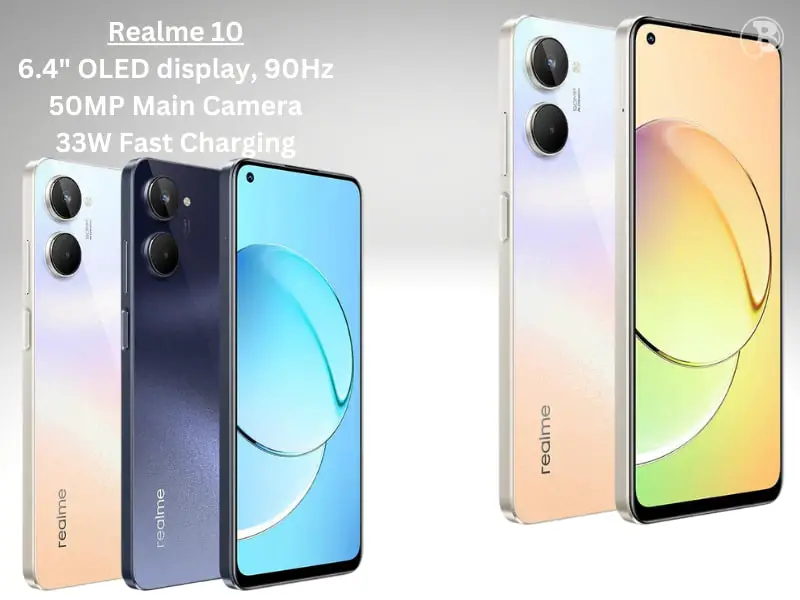
Even with a smaller size, it’s a solid screen with an sAMOLED panel and a 2400 x 1080 resolution. Images and videos look sharp, detailed, and punchy. But it only supports up to 90Hz refresh rate.
This helps motion and scrolling look smoother, but it isn’t as fluid as 120Hz like on the OnePlus Nord CE 3 Lite or POCO X5 Pro. A slight downgrade but 90Hz is still plenty for most users.
Powering the phone is the MediaTek Helio G99 which is a great budget processor. It’s in the same category as the Snapdragon 695 on the OnePlus Nord CE 3 Lite.
But it has a slight advantage in GPU scores and gaming, making it ideal for PUBG, Mobile Legends, and other mobile games. The processor is paired with 8GB RAM and 256GB storage so it’s got a good balance of performance and space.
You can also extend the memory with a micro-SD card up to 1TB.
On the rear, the Realme 10 has a dual camera setup with a 50MP main camera and 2MP depth sensor. The selfie camera is a standard 16MP shooter like on most other budget smartphones.
Compared to its predecessor the Realme 9, the Realme 10 has an upgraded processor, an updated flat, squarish design, and a bigger storage capacity. The Realme 10 also has a light particle design which changes the colour on the rear when light reflects off it.
It looks shiny, similar to glitter which you don’t often see on smartphones. This is a ‘unique’ design but doesn’t do much else. Though if you wanted a phone that stands out, the Realme 10 is a great choice.
As a whole, the Realme 10 is a solid budget smartphone for both day-to-day use and gaming. Its camera setup isn’t the most advanced, and it doesn’t have super-fast charging, but it gets the job done.
Pros:
- Unique ‘Light Particle’ Design
- Compact Size (6.4-inch Display)
- sAMOLED Panel for Punchy, Vibrant Colours
- 8GB RAM & 256GB Storage Capacity
- Solid Performer for Gaming
Cons:
- Only 90Hz Refresh Rate Support
- Simple Dual Camera Setup
- Only 33W Fast Charging Support
5. Vivo IQOO Z7 – Best Performing Smartphone Under RM1500
The Vivo IQOO Z7 is the Best Performing Smartphone Under RM1500 for good reason. It has the best processor in the price segment, the Snapdragon 782G making it the most reliable for day-to-day performance and gaming.
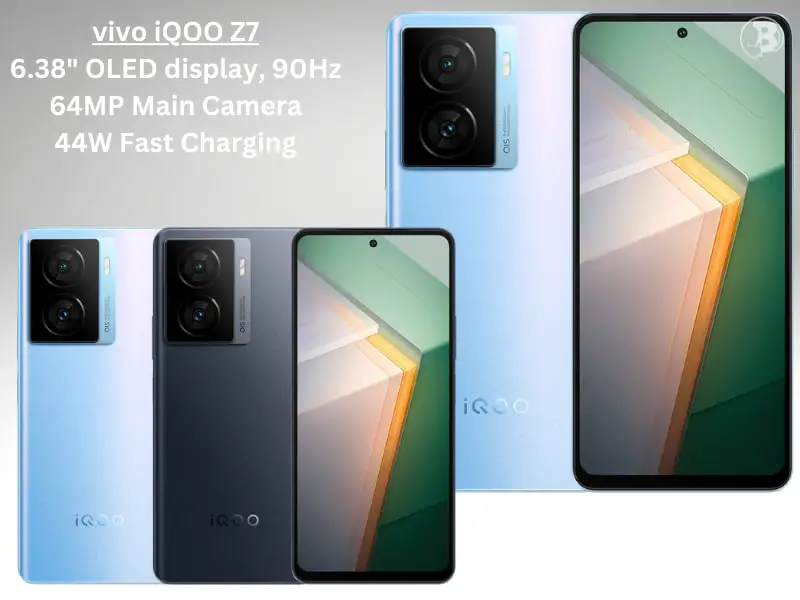
It’s a big leap forward from most budget processors like the Snapdragon 695 and Snapdragon 685. It also outscores its competitor, the POCO X5 Pro which has the older Snapdragon 778G chip.
The IQOO Z7 also has a solid display with a 6.6-inch LCD panel that supports a 2388 x 1080 resolution and a 120Hz refresh rate. Similar to the OnePlus Nord CE 3 Lite, the IQOO Z7 compromises on the display and doesn’t include an AMOLED panel.
This is unfortunate since almost every other spec on the IQOO Z7 is impressive. But everything still looks fluid and sharp, it’s just not as punchy or vibrant.
The IQOO Z7 has 8GB / 12GB RAM and up to 256GB storage. This is one of the only phones on the list to have a 12GB RAM model which makes it more efficient and faster.
Another great feature of the IQOO Z7 is the cameras. It’s a dual-camera setup with a 64MP main camera and a 2MP depth sensor. What’s most impressive is the main shooter has optical image stabilization.
This helps to keep images and videos blur-free from shaky hands or fast movements. It also improves photography in low light since it can automatically detect movement, and ensure the shot stays in focus.
You don’t usually see OIS on smartphones in this price range, making it a big feature for the IQOO Z7.
Compared to last year’s model, the IQOO Z6, the IQOO Z7 improves the processor, includes the OIS main camera, a bigger battery, and 120W fast charging. It’s a big improvement over its predecessor and very impressive for a smartphone under RM1500.
The only problem is the missing AMOLED panel. And while the 64MP OIS main camera is great, it’s fairly limited as you’re missing out on ultra-wide-angle shots and macro photography.
Putting these two things aside though, the Vivo IQOO Z7 is well worth the money. It’s an excellent performer, well-designed, has a super-fast 120W charge speed, and all-day battery life.
Pros:
- Excellent Performer w/ Snapdragon 782G Chip
- All-day Battery Life & Super-Fast 120W Charging
- 64MP Main Camera w/ Optical Image Stabilization
- 120Hz Refresh Rate Display
- Sleek & Stylish Design for a Budget Smartphone
Cons:
- No AMOLED Panel
- Limited Camera Capability (no ultra-wide/macro photography)
- Plastic Build
6. Xiaomi Redmi 9C
No budget Smartphone list is complete without mentioning this brand!
Released in the later end of 2020, together with the new version of the compatible Smartwatch (Mi Band 5):
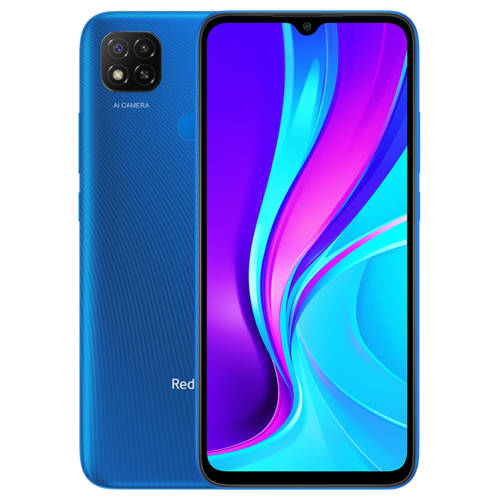
Xiaomi Redmi 9C is the upgraded version of the 9A. It may have the same display and expandable memory.
But there is now a fingerprint sensor. Plus, it’s powered by the MediaTek Helio G35 chip.
If you have the Redmi 9A and want to know how it compares to the Redmi 9C, there are 2 things you can look forward to in the newer model. The first is a better overall performance, and the second is the addition of 2 more lens for the rear camera!
Other comparable budget smartphones that are in the same price bracket include the Realme C11. And the Honor 9A!
In fact, the Xiaomi Redmi 9C actually runs on the same CPU and GPU present in the Realme C11.
Now you may be wondering if you should get the Realme C11 then:
On the contrary, the Xiaomi Redmi 9C is more worth your money (even if it costs a little more)! Because this model has a fingerprint scanner and more internal storage. Don’t forget that improved rear camera!
- Display: 6.53″ IPS LCD (720 x 1,600)
- Weight: 196g
- Dimensions: 164.9 x 77 x 9 mm
- OS: MIUI 12 / Android 10
- CPU: MediaTek Helio G35 Octa-Core
- GPU: PowerVR GE8320
- RAM: 3GB
- Storage: 64GB (Expandable Up to 256 GB via microSD)
- Battery Life: 5,000 mAh
- Rear Camera: 13MP (f/2.2) + 2MP (f/2.4) + 2MP (f/2.4)
- Front Camera: 5MP (f/2.2)
- IP Rating: n/a
- SIM Card: Dual Nano SIM
- Warranty: 1 Year
- Price: ~RM479
Pros:
- Triple cameras with satisfactory performance (considering the price of the phone)
- Dual-SIM
- Phone exterior does not smudge easily
- Solidly built
- Decent audio
- Affordable
Cons:
- Large sized and heavy phone with thick bezels
- Camera module protrudes out
- Charging is limited to 10W
- Screen is not bright enough for outdoors
- eMMC 5.1 storage interface
7. Samsung Galaxy A13
Alright, now this is one of the newest budget phones under Samsung:
Samsung Galaxy A13 brings with it an improvement in display (2408 x 1080 vs 1560 x 720) as well as performance (Exynos 850 with Mali-G52 vs Mediatek MT6765 Helio P35 with PowerVR GE8320) over the previous Samsung Galaxy A12.

Despite this, the screen is far from vibrant and the refresh rate could afford to be faster (90Hz). And if you’re coming from a premium phone, the Samsung Galaxy A13 is going to feel slow.
We would not recommend the Samsung Galaxy A13 for playing demanding games.
On another note, the Samsung Galaxy A13 is lighter than the A12 too (195g vs 205g). Although the phone is now wider and longer to accommodate the 6.6” IPS LCD (vs 6.5” IPS LCD in the Samsung Galaxy A12).
However, like its predecessor, the Samsung Galaxy A13 still carries the eMMC 5.1 storage interface where a UFS 2.1 would have been preferable at this price range!
The Samsung Galaxy A13 maintains the hefty internal storage (128GB) that can still be expanded to 512GB! This is paired with a RAM of 6GB.
Battery capacity remains the same at 5000mAh. Tests by gsmarena show that the Samsung Galaxy A13 is able to run for more than 110 hours. Both the rear and front camera specs aremore or less the same (the rear camera is now 50MP with a wider aperture of f/1.8 vs 48MP and f/2.0).
So this budget phone is not the best but still offers better camera performance compared to cheaper models. Even if it struggles in low lighting situations.
Verdict: Best Samsung Budget Phone
Samsung Galaxy A13 still has a slow performance despite the upgrades from A12. The display (not OLED) and camera(s) are nothing to shout about.
But the Samsung Galaxy A13 is one of the cheapest Samsung Android Smartphones around. And that amazing battery life will carry you through most of the day.
- Display: 6.6″ IPS LCD (1080 x 2408)
- Weight: 195g
- Dimensions: 165.1 x 76.4 x 8.8 mm
- OS: One UI 4.1 / Android 12
- CPU: Exynos 850, Octa-Core
- GPU: Mali-G52
- RAM: 6GB
- Storage: 128GB (Expandable Up To 512GB via microSD)
- Battery Life: 5,000 mAh
- Rear Camera: 50MP (f/1.8) + 5MP (f/2.2) + 2MP (f/2.4) + 2MP (f/2.4)
- Front Camera: 8MP (f/2.2)
- IP Rating: n/a
- SIM Card: Dual SIM (Nano SIM)
- Warranty: 1 Year
- Price: ~RM689
Pros:
- The main camera takes satisfactory pictures
- Battery life is long
- Performance is great considering the price point
- Huge built-in internal memory storage
- Dual sim capability
- Fast charging 15W capability
- Sports a fingerprint scanner
Cons:
- Not suitable for gamers
- With old flash technology (eMMC 5.1)
- Sides of screen tend to trap dust
- Plastic-y build
- 15W fast charger not included
8. Xiaomi Poco M3 Pro 5G
Taking over the former Xiaomi Poco X3 NFC, the new Xiaomi Poco M3 Pro 5G might have a smaller screen now (6.5″ vs 6.67″ IPS LCD) but the resolution is the same (1,080 x 2,400) with a refresh rate of 90Hz.
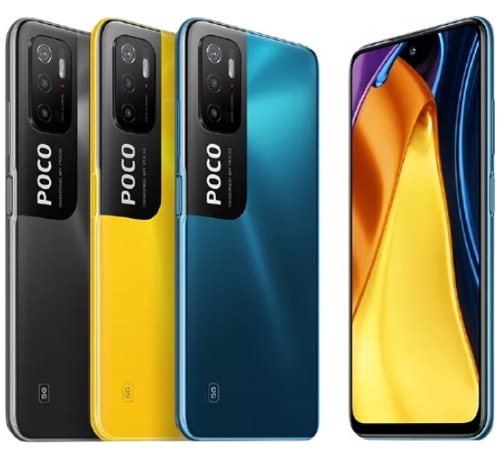
Like the Xiaomi Poco X3 NFC, the Xiaomi Poco M3 Pro 5G still has an enjoyable display with plenty of contrast.
It’s also less bulky (161.8 x 75.3 x 8.9 mm vs 165.3 x 76.8 x 9.4 mm), lighter (190g vs 215g) and cheaper (under RM800 vs RM900). The compromise is a downgrade for the rear (64MP to 48MP) and front camera (20MP to 8MP).
The Xiaomi Poco M3 Pro 5G does only have an average camera performance – good enough for casual use – selfies are surprisingly nice. And it has lost the dual stereo speakers but we will say the speakers are decent anyways.
Besides this, there is now a slightly smaller battery (5,000 mAh vs 5,160 mAh) with 18W fast charging (the previous model could take 33W). RAM is less too (6GB/8GB to 4GB/6GB).
For storage, the most you can get is with the 128GB version where you can expand it up to 256GB via microSD.
This phone retains the IP53 rating of the former model, whichis a wonder because you don’t often see this on a budget Smartphone!
However, the Xiaomi Poco M3 Pro 5G can no longer do what its predecessor, the Xiaomi Poco X3 NFC excelled at – 4K video recording.
Gaming is still possible but just at a satisfactory level with lower settings engaged. At least you won’t have to worry about battery life!
Verdict: Best Overall Value (Under RM700)
If you’re looking for a phone under RM 1,000 that is equipped for 5G, the Xiaomi Poco M3 Pro 5G might interest you. Because the Xiaomi Poco M3 Pro 5G is one of the most affordable entry-level 5G SmartPhones right now.
But that would be the only reason to get it though as it has lost many features that made the previous Xiaomi Poco X3 NFC so great!
- Display: 6.5″ IPS LCD (1080 x 2400) 500nits 90Hz
- Weight: 190g
- Dimensions: 161.8 x 75.3 x 8.9 mm
- OS: MIUI 12 / Android 11
- CPU: MediaTek MT6833 Dimensity 700 Octa-Core
- GPU: Mali-G57 MC2
- Storage: 64GB / 128GB (Expandable Up to 256 GB via microSD)
- Battery Life: 5,000 mAh, Fast charging 18W
- Rear Camera: 48MP (f/1.9) + 2MP (f/2.4) + 2MP (f/2.4)
- Front Camera: 8MP (f/2.0)
- IP Rating: IP53
- SIM Card: Hybrid Dual SIM (Nano SIM)
- Warranty: 1 Year
- Price: ~From RM699 to RM799
Pros:
- With 5G and NFC support
- Cheap but has decent performance
- Can support dual SIM
- Phone has a 3.5mm audio jack and IR blaster
- IP53 waterproof rating
- Fantastic battery life (almost 2 days with minimal use)
- Comfortable and no longer bulky
- Possible to switch to 60Hz mode to save on battery
- MiUI 12 is use-friendly
Cons:
- Camera performance is only ok
- 18W fast charging (much lower than previous model)
- Back attracts dust and fingerprints easily
- Doesn’t get too hot while gaming
- Numerous bloatware
- Macro lens is not good
9. Realme Narzo 50 Gaming Smartphone
With the HUAWEI Nova 8i Smartphone out of the picture, gamers will look to the Realme Narzo 50 Gaming Smartphone for a budget gaming Smartphone under RM1,000.
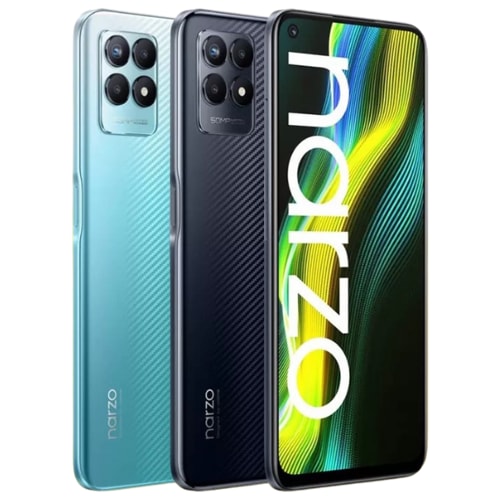
There are two versions and since the higher spec 6GB/128GB costs ~RM100 more, we’d recommend going for it instead of the lower spec (4GB/64GB).
The camera performance (including night mode) of the Realme Narzo 50 Gaming Smartphone isn’t too shabby either. You can even shoot videos from both sides of the phone simultaneously!
And while the Realme Narzo 50 Gaming Smartphone’s fast charging is no match for the HUAWEI Nova 8i Smartphone’s, it’s still fast at 33W.
But the real highlight of the Realme Narzo 50 Gaming Smartphone is the chipset, the Mediatek Helio G96 which should allow you to play most games lag-free, at least at the medium settings for graphic-intensive games.
For those wondering, the Realme Narzo 50 Gaming Smartphone is capable of playing Mobile Legends at high settings with minimal lag.
Verdict: Best For Gaming
So currently, the Realme Narzo 50 Gaming Smartphone is the best budget phone for gaming in Malaysia. How many budget smartphones can tout a refresh rate of 120Hz for their LCD display? You can switch that refresh rate to 60Hz to save battery too.
Maybe you don’t need even a Smart TV when you have the Realme Narzo 50 Gaming Smartphone and its huge screen!
- Display: 6.6″ IPS LCD (1080 x 2412), 120Hz
- Weight: 194g
- Dimensions: 164.1 x 75.5 x 8.5 mm
- OS: Realme UI 2.0 / Android 11
- CPU: Mediatek Helio G96 Octa-Core
- GPU: Mali-G57 MC2
- RAM: 4GB / 6GB
- Storage: 64GB / 128GB (Expandable Up To 512GB via microSD)
- Battery Life: 5,000 mAh, Fast charging 33W
- Rear Camera: 50MP (f/1.8) + 2MP (f/2.4) + 2MP (f/2.4)
- Front Camera: 16MP (f/2.1)
- IP Rating: n/a
- SIM Card: Dual SIM (Nano SIM)
- Warranty: 1 Year
- Price: ~RM779
Pros:
- Great performance
- Crispy LCD display with 120Hz refresh rate and 401 pixel density
- Affordable (~RM800)
- Attractive and unique sporty design
- Expandable memory
- Supports dual sim use
- Better than average camera performance in this price range
- Fast charger (33W) included
- Fast charging (0 to 70% in an hour)
Cons:
- No NFC capability
- Quite heavy
- Back of phone attracts fingerprints
- No stereo speakers
- Camera doesn’t support ultra-wide shots
10. vivo T1x
vivo T1x was released together with the vivo T1 5G and here’s the lowdown on the 4G version, the vivo T1x:
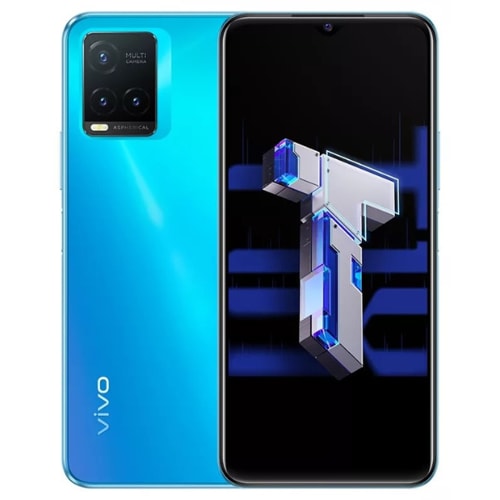
Firstly, there are some notable features like the 1080p HD LCD display which has a 90Hz refresh rate, a 50MP triple camera setup, as well as the sizeable 5000mAh battery.
If you play a lot of games though, get a microSD to boost up the 64GB of storage with another 128GB.
The vivo T1x is capable of running Mobile Legends or League Of Legends: Wild Rift at high settings while Call of Duty will require you to run at medium settings. It is even possible to play Genshin Impact with this phone though on a casual basis.
Verdict
The vivo T1x is an unexpectedly good option for an entry-level gaming Smartphone.
But you might also want to look at the Realme Narzo 50 Gaming Smartphone if you’re serious about gaming and can only afford a phone in this price range.
- Display: 6.58″ IPS LCD (1080 x 2408) 90Hz
- Weight: 182g
- Dimensions: 164 x 75.3 x 8.5 mm
- OS: OriginOS / Android 11
- CPU: Qualcomm SM6225 Snapdragon 680 4G Octa-Core
- GPU: Adreno 610
- RAM: 4GB / 8GB
- Storage: 64GB / 128GB (Not Expandable)
- Battery Life: 5,000 mAh, Fast charging 18W
- Rear Camera: 50 MP, f/1.8 + 2 MP, f/2.4 + 2 MP, f/2.4
- Front Camera: 8 MP, f/1.8
- IP Rating: n/a
- SIM Card: Dual SIM (Nano SIM)
- Warranty: 1 Year
- Price: ~RM899
Pros:
- Sound battery life (not excellent but satisfactory)
- Display is good for the price range
- Fast charger provided
- Affordable
Cons:
- No NFC
- Heats up quickly during gaming
- Average camera performance
- Takes 2 hours to fully charge with the 18W fast charging
- No stereo speakers
11. POCO M4 Pro
POCO M4 Pro has one of the smallest screens in this list of budget Smartphones in Malaysia. But it is an AMOLED display (the first in the POCO M-series) which has a 90Hz refresh rate and a maximum brightness of 700nits where many other budget Smartphones in this price range (like the vivo T1x) still bear an LCD display.
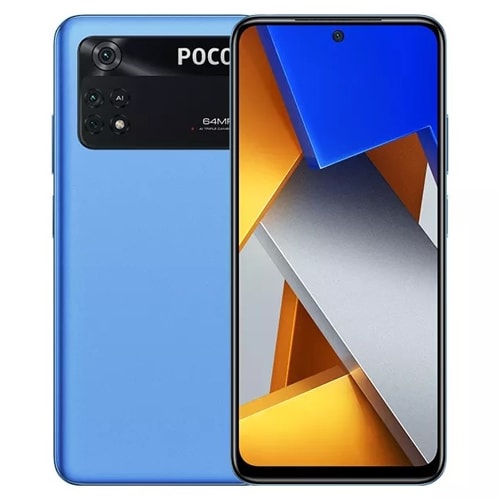
However, even with that wonderful OLED display, the POCO M4 Pro sadly doesn’t have HDR support which is a bummer if you often stream from platforms like YouTube.
This phone is not very heavy at less than 180g, even though it packs a 5,000mAh battery (that is also fast charging at 33W). Under the hood, the Mediatek G96 is not known for its energy efficiency though.
Another gripe is that the POCO M4 Pro phone won’t carry you into the 5G phase. Unlike the Xiaomi Poco M3 Pro 5G.
But if that doesn’t bother you, there are other aspects of this phone to look forward to:
Such as the 64MP triple-camera set up, stereo speakers, and generous storage (up to 256GB via microSD).
Verdict: Best Overall Value (Under RM1,000) With AMOLED Display
The compact POCO M4 Pro is not perfect. However, it’s hard to resist its premium features at this competitive price point!
- Display: 6.43″ AMOLED (1080 x 2400) 90Hz 700nits
- Weight: 179.5g
- Dimensions: 159.9 x 73.9 x 8.1 mm
- OS: MIUI 13 / Android 11
- CPU: Mediatek Helio G96 Octa-Core
- GPU: Mali-G57 MC2
- RAM: 6GB / 8GB
- Storage: 128GB / 256GB (Expandable via microSD)
- Battery Life: 5,000 mAh, Fast charging 33W
- Rear Camera: 64 MP, f/1.8 + 8 MP, f/2.2 + 2 MP, f/2.4
- Front Camera: 16 MP, f/2.5
- IP Rating: IP53
- SIM Card: Dual SIM (Nano SIM)
- Warranty: 1 Year
- Price: ~RM899
Pros:
- Fast charging 18W
- Dual selfie camera (with good autofocus)
- Has a fingerprint sensor
- Memory can be expanded (microSD)
- Dual sim capability
- Bright and sharp screen that supports multitouch
- Still has space for a 3.5mm audio jack
- Doesn’t look cheap
Cons:
- Slightly above RM1000
- Battery is not removable
- Fingerprints are easily seen on the black cover
- Plastic build
Conclusion
There are decent budget Smartphones in Malaysia at the RM500 price mark. But if you play many games, you might want to consider increasing that budget to RM1,000.
And if 5G capability is the reason you want to upgrade but don’t want to spend more than RM1,000, consider the Xiaomi Poco M3 Pro 5G.
Introducing The New Xiaomi POCO X4 Pro 5G (2022)
Further reading:
- 13 Best Bluetooth Wireless Earbuds In Malaysia
- 15 Best Power Bank Malaysia
- 13 Best Android TV Box Malaysia
- 11 Best Laptops To Buy In Malaysia
- 13 Best Dash Cams Malaysia

